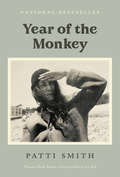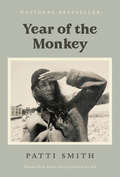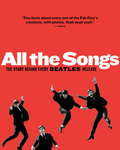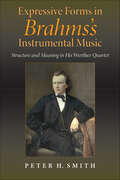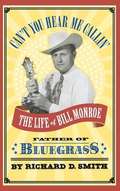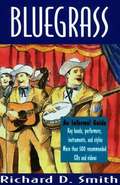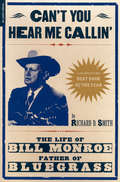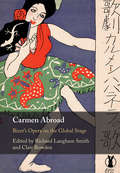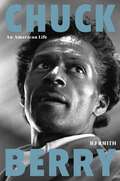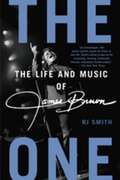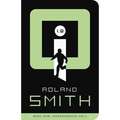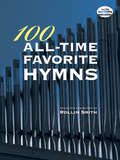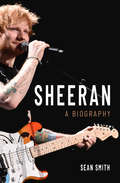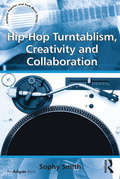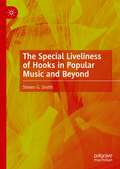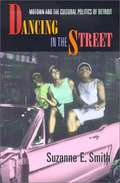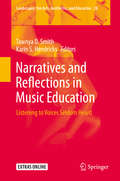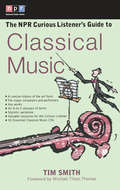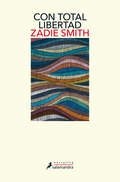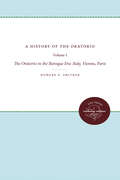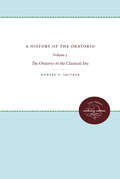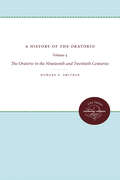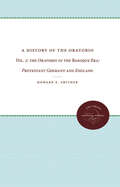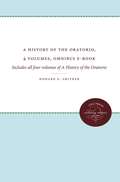- Table View
- List View
Year of the Monkey
by Patti SmithFrom the National Book Award-winning author of Just Kids and M Train, a profound, beautifully realized memoir in which dreams and reality are vividly woven into a tapestry of one transformative year. <P><P>Following a run of New Year's concerts at San Francisco's legendary Fillmore, Patti Smith finds herself tramping the coast of Santa Cruz, about to embark on a year of solitary wandering. Unfettered by logic or time, she draws us into her private wonderland with no design, yet heeding signs--including a talking sign that looms above her, prodding and sparring like the Cheshire Cat. <P><P>In February, a surreal lunar year begins, bringing with it unexpected turns, heightened mischief, and inescapable sorrow. In a stranger's words, "Anything is possible: after all, it's the Year of the Monkey." <P><P>For Smith--inveterately curious, always exploring, tracking thoughts, writing--the year evolves as one of reckoning with the changes in life's gyre: with loss, aging, and a dramatic shift in the political landscape of America. <P><P>Smith melds the western landscape with her own dreamscape. Taking us from California to the Arizona desert; to a Kentucky farm as the amanuensis of a friend in crisis; to the hospital room of a valued mentor; and by turns to remembered and imagined places, this haunting memoir blends fact and fiction with poetic mastery. The unexpected happens; grief and disillusionment set in. <P><P>But as Smith heads toward a new decade in her own life, she offers this balm to the reader: her wisdom, wit, gimlet eye, and above all, a rugged hope for a better world. Riveting, elegant, often humorous, illustrated by Smith's signature Polaroids, Year of the Monkey is a moving and original work, a touchstone for our turbulent times. <P><P><b>A New York Times Bestseller</b>
Year of the Monkey
by Patti SmithFrom the National Book Award-winning author of Just Kids and M Train, a profound, beautifully realized memoir in which dreams and reality are vividly woven into a tapestry of one transformative year.Following a run of New Year's concerts at San Francisco's legendary Fillmore, Patti Smith finds herself tramping the coast of Santa Cruz, about to embark on a year of solitary wandering. Unfettered by logic or time, she draws us into her private wonderland with no design, yet heeding signs--including a talking sign that looms above her, prodding and sparring like the Cheshire Cat. In February, a surreal lunar year begins, bringing with it unexpected turns, heightened mischief, and inescapable sorrow. In a stranger's words, "Anything is possible: after all, it's the Year of the Monkey." For Smith--inveterately curious, always exploring, tracking thoughts, writing--the year evolves as one of reckoning with the changes in life's gyre: with loss, aging, and a dramatic shift in the political landscape of America.Smith melds the western landscape with her own dreamscape. Taking us from California to the Arizona desert; to a Kentucky farm as the amanuensis of a friend in crisis; to the hospital room of a valued mentor; and by turns to remembered and imagined places, this haunting memoir blends fact and fiction with poetic mastery. The unexpected happens; grief and disillusionment set in. But as Smith heads toward a new decade in her own life, she offers this balm to the reader: her wisdom, wit, gimlet eye, and above all, a rugged hope for a better world.Riveting, elegant, often humorous, illustrated by Smith's signature Polaroids, Year of the Monkey is a moving and original work, a touchstone for our turbulent times.
All The Songs: The Story Behind Every Beatles Release (All the Songs)
by Patti Smith Jean-Michel Guesdon Scott Freiman Philippe Margotin**NOTE: EBOOK DOES NOT INCLUDE ANY IMAGES**Every album and every song ever released by the Beatles?from "Please Please Me" (U.S. 1963) to "The Long and Winding Road" (U.S. 1970)?is dissected, discussed, and analyzed by two music historians in this lively and fully illustrated work.All the Songs delves deep into the history and origins of the Beatles and their music. This first-of-its-kind book draws upon decades of research, as music historians Margotin and Guesdon recount the circumstances that led to the composition of every song, the recording process, and the instruments used.Here, we learn that one of John Lennon's favorite guitars was a 1958 Rickenbacker 325 Capri, which he bought for £100 in 1960 in Hamburg, Germany. We also learn that "Love Me Do," recorded in Abbey Road Studios in September 1962, took 18 takes to get right, even though it was one of the first songs John and Paul ever wrote together. And the authors reveal that when the Beatles performed "I Want to Hold Your Hand" on The Ed Sullivan Show in 1964, John's microphone wasn't turned on, so viewers heard only Paul singing.All the Songs is the must-have Beatles book for the any true Beatles fan.
Expressive Forms in Brahms's Instrumental Music: Structure and Meaning in His Werther Quartet (Musical Meaning and Interpretation)
by Peter H. Smith"This book is a substantial and timely contribution to Brahms studies. Its strategy is to focus on a single critical work, the C-Minor Piano Quartet, analyzing and interpreting it in great detail, but also using it as a stepping-stone to connect it to other central Brahms works in order to reach a new understanding of the composer's technical language and expressive intent. It is an original and worthy contribution on the music of a major composer." —Patrick McCrelessExpressive Forms in Brahms's Instrumental Music integrates a wide variety of analytical methods into a broader study of theoretical approaches, using a single work by Brahms as a case study. On the basis of his findings, Smith considers how Brahms's approach in this piano quartet informs analyses of similar works by Brahms as well as by Beethoven and Mozart.Musical Meaning and Interpretation—Robert S. Hatten, editor
Can't You Hear Me Callin': The Life Of Bill Monroe, Father Of Bluegrass
by Richard A. SmithFrom the book jacket: Elvis Presley chose one of his songs, "Blue Moon of Kentucky," for his first single. A young Jerry Garcia traveled crosscountry to audition for his band. Johnny Cash, Buddy Holly, and even Frank Sinatra were fans. Considering the range of stars and styles that claim him as an influence, no single artist has had as broad an impact on American popular music as Bill Monroe. Born in 1911 in rural Kentucky, Monroe melded the fiddle tunes, ballads, and blues of his youth into the "high lonesome" sound known today as bluegrass, making him perhaps the only performer to create an entire musical genre. His distinctive bluegrass style profoundly influenced country, early rock 'n' roll, and the folk revival of the 1960s. A Grand Ole Opry star for almost sixty years, Monroe was a searing mandolinist who redefined the instrument, a haunting high-range vocalist, and a godlike figure to generations of admirers who became famous in their own right. When Monroe died in 1996, he was universally acclaimed as "the Father of Bluegrass," but the personal life of this taciturn figure remained largely unknown. His childhood feelings of isolation and abandonment- "lonesomeness" he called it-fueled his reckless womanizing in adulthood and inspired his most powerful compositions. From his professional breakthrough in the Monroe Brothers duet act to his bitter rivalry with former sidemen Lester Flatt and Earl Scruggs to his final days as a revered elder statesman of bluegrass, Monroe's career was filled with trials and triumphs. Now, veteran bluegrass journalist Richard D. Smith has interviewed a multitude of Monroe's surviving friends, lovers, colleagues, and contemporaries to create a three-dimensional portrait of this brilliant, complex, and contradictory man. Compel lingly narrated and thoroughly researched, Can't You Hear Me Callin' is the definitive biography of a true giant of American music. RICHARD D. SMITH is a journalist whose work has appeared in a number of national publications, including the NewYork Times, Bloomberg magazine, and the Journal of Country Music. The author of Bluegrass: An Informal Guide, he is also a reviewer for Bluegrass Unlimited magazine and plays mandolin and guitar. He lives in Rocky Hill, New Jersey.
Bluegrass: An Informal Guide
by Richard D. SmithCreated by legendary Bill Monroe of Kentucky and made famous by his Blue Grass Boys, bluegrass has been sweeping musicians and audiences off their feet since 1939. This lively and authoritative guide covers: all the important sounds from traditional Monroe-style bluegrass, jazz-flavoured northern 'newgrass', and Nashville-influenced country grass to the distinctive sounds of Japanese and European bands; famous groups, instrumentalists, and vocalists; women blue grassers; with insider anecdotes, resource listings, the lowdown on bluegrass festivals, and more than 500 recommendations for listening.
Can't You Hear Me Callin': The Life of Bill Monroe Father of Bluegrass
by Richard D. SmithNow in paperback: The definitive biography of the father of bluegrass, who did what no other individual has done: invented an entire genre of music. -Chicago Tribune.
Carmen Abroad: Bizet's Opera on the Global Stage
by Richard Langham Smith Clair RowdenFrom the 'old world' to the 'new' and back again, this transnational history of the performance and reception of Bizet's Carmen – whose subject has become a modern myth and its heroine a symbol – provides new understanding of the opera's enduring yet ever-evolving and resituated presence and popularity. This book examines three stages of cultural transfer: the opera's establishment in the repertoire; its performance, translation, adaptation and appropriation in Europe, the Americas and Australia; its cultural 'work' in Soviet Russia, in Japan in the era of Westernisation, in southern, regionalist France and in Carmen's 'homeland', Spain. As the volume reveals the ways in which Bizet's opera swiftly travelled the globe from its Parisian premiere, readers will understand how the story, the music, the staging and the singers appealed to audiences in diverse geographical, artistic and political contexts.
Chuck Berry: An American Life
by RJ SmithThe definitive biography of Chuck Berry, legendary performer and inventor of rock and roll Best known as the groundbreaking artist behind classics like &“Johnny B. Goode,&” &“Maybellene,&” &“You Never Can Tell&” and &“Roll Over Beethoven,&” Chuck Berry was a man of wild contradictions, whose motives and motivations were often shrouded in mystery. After all, how did a teenage delinquent come to write so many songs that transformed American culture? And, once he achieved fame and recognition, why did he put his career in danger with a lifetime&’s worth of reckless personal behavior? Throughout his life, Berry refused to shed light on either the mastery or the missteps, leaving the complexity that encapsulated his life and underscored his music largely unexplored—until now. In Chuck Berry, biographer RJ Smith crafts a comprehensive portrait of one of the great American entertainers, guitarists, and lyricists of the 20th century, bringing Chuck Berry to life in vivid detail. Based on interviews, archival research, legal documents, and a deep understanding of Berry&’s St. Louis (his birthplace, and the place where he died in March 2017), Smith sheds new light on a man few have ever really understood. By placing his life within the context of the American culture he made and eventually withdrew from, we understand how Berry became such a groundbreaking figure in music, erasing racial boundaries, crafting subtle political commentary, and paying a great price for his success. While celebrating his accomplishments, the book also does not shy away from troubling aspects of his public and private life, asking profound questions about how and why we separate the art from the artist. Berry declined to call himself an artist, shrugging that he was good at what he did. But the man's achievement was the rarest kind, the kind that had social and political resonance, the kind that made America want to get up and dance. At long last, Chuck Berry brings the man and the music together.
The One: The Life and Music of James Brown
by Rj SmithThe definitive biography of James Brown, the Godfather of Soul, with fascinating findings on his life as a Civil Rights activist, an entrepreneur, and the most innovative musician of our time Playing 350 shows a year at his peak, with more than forty Billboard hits, James Brown was a dazzling showman who transformed American music. His life offstage was just as vibrant, and until now no biographer has delivered a complete profile. The One draws on interviews with more than 100 people who knew Brown personally or played with him professionally. Using these sources, award-winning writer RJ Smith draws a portrait of a man whose twisted and amazing life helps us to understand the music he made.The One delves deeply into the story of a man who was raised in abject-almost medieval-poverty in the segregated South but grew up to earn (and lose) several fortunes. Covering everything from Brown's unconventional childhood (his aunt ran a bordello), to his role in the Black Power movement, which used "Say It Loud (I'm Black and Proud)" as its anthem, to his high-profile friendships, to his complicated family life, Smith's meticulous research and sparkling prose blend biography with a cultural history of a pivotal era.At the heart of The One is Brown's musical genius. He had crucial influence as an artist during at least three decades; he inspires pity, awe, and revulsion. As Smith traces the legend's reinvention of funk, soul, R&B, and pop, he gives this history a melody all its own.
The One
by Rj SmithThe definitive biography of James Brown, the Godfather of Soul, with fascinating findings on his life as a Civil Rights activist, an entrepreneur, and the most innovative musician of our time Playing 350 shows a year at his peak, with more than forty Billboard hits, James Brown was a dazzling showman who transformed American music. His life offstage was just as vibrant, and until now no biographer has delivered a complete profile. The One draws on interviews with more than 100 people who knew Brown personally or played with him professionally. Using these sources, award-winning writer RJ Smith draws a portrait of a man whose twisted and amazing life helps us to understand the music he made. The One delves deeply into the story of a man who was raised in abject-almost medieval-poverty in the segregated South but grew up to earn (and lose) several fortunes. Covering everything from Brown's unconventional childhood (his aunt ran a bordello), to his role in the Black Power movement, which used "Say It Loud (I'm Black and Proud)" as its anthem, to his high-profile friendships, to his complicated family life, Smith's meticulous research and sparkling prose blend biography with a cultural history of a pivotal era. At the heart of The One is Brown's musical genius. He had crucial influence as an artist during at least three decades; he inspires pity, awe, and revulsion. As Smith traces the legend's reinvention of funk, soul, R&B, and pop, he gives this history a melody all its own.
Independence Hall (I.Q. #1)
by Roland SmithTeenagers Q (Quest) and Angela are accompanying rockers Blaze and Roger on their U.S. tour. In Philadelphia, Angela realizes she's being followed, and Q soon learns the secret about Angela's real mother--a former Secret Service agent.
100 All-Time Favorite Hymns (Dover Music for Organ)
by Rollin SmithSpecially arranged for organ but playable on any keyboard instrument, this collection features such beloved hymns as A Mighty Fortress Is Our God, Amazing Grace, and Onward, Christian Soldiers. Compiled by a specialist in the organ repertoire, this modestly priced volume features a lay-flat sewn binding, Introduction, and Indexes.
Sheeran: A Biography
by Sean SmithThe first comprehensive adult biography of the beloved, redheaded “Shape of You” songster, complete with exclusive interviews and all-new research! Grammy-award winner Ed Sheeran strikes chords in millions of listeners worldwide—a feat all the more staggering given that he couldn’t even carry a tune until the age of fifteen. At thirteen, then just a guitarist in a school rock band, today’s most successful solo star decided he would fly far higher than hometown fame. Within a year, he had recorded an album in his bedroom. Bestselling biographer Sean Smith traces the astonishing journey of the shy little English boy with a stammer who, avoiding flashy showmanship, grew up to become a global phenomenon. With compelling new research and interviews, Smith delivers the story of Sheeran’s remarkable parents, who supported their son’s dream long before it seemed achievable; the friends and mentors who encouraged his raw talent; and the lovers who inspired his most famous songs. Smith describes the setbacks Sheeran faced before his fortunes were transformed by Elton John’s management company, a record deal, and a song that changed everything…with some help from Taylor Swift. Now Sheeran has sold 150 million records worldwide, earned $432 million touring in 2018 alone, and broke records with his 2018 UK tour—but still made time to play for just 400 people at a charity night to raise money for the homeless last year. As this captivating book reveals, there’s no one quite like Ed.
Hip-Hop Turntablism, Creativity and Collaboration (Ashgate Popular and Folk Music Series)
by Sophy SmithArmed only with turntables, a mixer and a pile of records, hip-hop DJs and turntable musicians have changed the face of music. However, whilst hip-hop has long been recognised as an influential popular culture both culturally and sociologically, hip-hop music is rarely taken seriously as an artistic genre. Hip-Hop Turntablism, Creativity and Collaboration values hip-hop music as worthy of musicological attention and offers a new approach to its study, focusing on the music itself and providing a new framework to examine not only the musical product, but also the creative process through which it was created. Based on ten years of research among turntablist communities, this is the first book to explore the creative and collaborative processes of groups of DJs working together as hip-hop turntable teams. Focusing on a variety of subjects - from the history of turntable experimentation and the development of innovative sound manipulation techniques, to turntable team formation, collective creation and an analysis of team routines - Sophy Smith examines how turntable teams have developed new ways of composing music, and defines characteristics of team routines in both the process and the final artistic product. Relevant to anyone interested in turntable music or innovative music generally, this book also includes a new turntable notation system and methodology for the analysis of turntable compositions, covering aspects such as material, manipulation techniques and structure as well as the roles of individual musicians.
The Special Liveliness of Hooks in Popular Music and Beyond
by Steven G. SmithThis book illuminates the aesthetically underrated meaningfulness of particular elements in works of art and aesthetic experiences generally. Beginning from the idea of "hooks" in popular song, the book identifies experiences of special liveliness that are of enduring interest, supporting contemplation and probing discussion. When hooks are placed in the foreground of aesthetic experience, so is an enthusiastic “grabbing back” by the experiencer who forms a quasi-personal bond with the beloved singular moment and is probably inclined to share this still-evolving realization of value with others. This book presents numerous models of enthusiastic “grabbing back” that are art-critically motivated to explain how hooks achieve their effects and philosophically motivated to discover how hooks and hook appreciation contribute to a more ideally desirable life. Framing hook appreciation with a defensible general model of aesthetic experience, this book gives an unprecedented demonstration of the substantial aesthetic and philosophical interest of hook-centered inquiry.
Dancing in the Street: Motown and the Cultural Politics of Detroit
by Suzanne E. SmithDetroit in the 1960s was a city with a pulse: people were marching in step with Martin Luther King, Jr., dancing in the street with Martha and the Vandellas, and facing off with city police. Through it all, Motown provided the beat. This book tells the story of Motown--as both musical style and entrepreneurial phenomenon--and of its intrinsic relationship to the politics and culture of Motor Town, USA. <p><p>As Suzanne Smith traces the evolution of Motown from a small record company firmly rooted in Detroit's black community to an international music industry giant, she gives us a clear look at cultural politics at the grassroots level. Here we see Motown's music not as the mere soundtrack for its historical moment but as an active agent in the politics of the time. In this story, Motown Records had a distinct role to play in the city's black community as that community articulated and promoted its own social, cultural, and political agendas. Smith shows how these local agendas, which reflected the unique concerns of African Americans living in the urban North, both responded to and reconfigured the national civil rights campaign. <p><p>Against a background of events on the national scene--featuring Martin Luther King, Jr., Langston Hughes, Nat King Cole, and Malcolm X--Dancing in the Street presents a vivid picture of the civil rights movement in Detroit, with Motown at its heart. This is a lively and vital history. It's peopled with a host of major and minor figures in black politics, culture, and the arts, and full of the passions of a momentous era. It offers a critical new perspective on the role of popular culture in the process of political change.
Narratives and Reflections in Music Education: Listening to Voices Seldom Heard (Landscapes: the Arts, Aesthetics, and Education #28)
by Tawnya D. Smith Karin S. HendricksThis volume offers chapters written by some of the most respected narrative and qualitative inquiry writers in the field of music education. The authorship and scope are international, and the chapters advance the philosophical, theoretical, and methodological bases of narrative inquiry in music education and the arts. The book contains two sections, each with a specific aim. The first is to continue and expand upon dialogue regarding narrative inquiry in music education, emphasizing how narrative involves the art of listening to and hearing others whose voices are often unheard. The chapters invite music teachers and scholars to experience and confront music education stories from multiple perspectives and worldviews, inviting an international readership to engage in critical dialogue with and about marginalized voices in music. The second section focuses on ways in which narrative might be represented beyond the printed page, such as with music, film, photography, and performative pieces. This section includes philosophical discussions about arts-based and aesthetic inquiry, as well as examples of such work.
The NPR Curious Listener's Guide to Classical Music
by Tim Smith Michael Tilson ThomasFor the beginner or the devotee--it's everything the classical music buff needs to know. The major composers from Bach and Bartok to Rachmaninoff and Tchaikovsky Significant performers from Maurice Andre and Leornard Bernstein to Georg Solti and Yo Yo Ma The landmark works from Appalachian Spring to Don Juan A concise history of classical music A deconstruction of the art form The language of classical music Valuable resources for the Curious Listener
Con total libertad
by Zadie SmithUn libro cargado de agudeza, frescura y empatía que nos ilumina en un mundo cada vez más cambiante y contradictorio. Zadie Smith ha demostrado ser una ensayista brillante y singular, haciendo que cada texto suyo sea un acontecimiento literario por derecho propio. Con total libertad, que recopila algunos de los más celebrados, abarca el amplísimo rango de intereses de Smith: desde todas las facetas de la cultura y la libertad artística hasta los temas más acuciantes de la política y la actualidad, siempre desde una perspectiva original y radicalmente personal. Gracias a su fina agudeza, una frescura contagiosa y una empatía extraordinaria, este libro es una guía imprescindible para entender un mundo, el nuestro, cada vez más complejo y contradictorio. La crítica ha dicho:«Ecléctica en sus gustos y centrífuga en su estilo, Zadie Smith disfruta, como articulista, de ampliar los límites de su pensamiento [...] En la línea de Hazlitt y Orwell, Woolf y Angela Carter.»The Financial Times «Interesante, sagaz [...]¿Se debe leer este libro brillante? ¡Por supuesto que sí!»The Independent «Un libro inteligente, ingenioso y a menudo hilarante que demuestra que (Zadie Smith) es una de las mentes más brillantes de la literatura británica de hoy en día.»NPR «Es un placer exquisito observar a Zadie Smith pensar a lo largo de estas páginas.»The New York Times Book Review «Smith lleva a la escritura de artículos sus dotes como novelista: buen ojo para el detalle, sutiles giros en las frases.»The Boston Globe «Estos ensayos en su conjunto reflejan una mente abierta, vivaz, natural, rigurosa, erudita y seria, ocupada en perfeccionar su manera de ver la vida, la literatura y la relación entre ambas. Smith demuestra que es mucho más que una cabeza adulta y comprensiva sobre unos hombros muy jóvenes. Y lo demuestra con su apasionada, compulsivamente dialéctica y atractiva indagación de la literatura».Los Angeles Times «No importa sobre lo que escriba -su padre, Kafka, Liberia, George Clooney-: colocar cualquier tema dentro del campo magnético de su cerebro incansable basta para volverlo fascinante. Smith [...] tiene el don de mostrarnos cómo lee y piensa; al ver cómo lo hace, uno se siente a su vez más inteligente y observador por ósmosis.»Time
A History of the Oratorio: Vol. 1: The Oratorio in the Baroque Era: Italy, Vienna, Paris
by Howard E. SmitherHoward Smither has written the first definitive work on the history of the oratorio since Arnold Schering published his Geschichte des Oratoriums in 1911. This volume is the first of a four-volume comprehensive study that offers a new synthesis of what is known to date about the oratorio.Volume 1, divided into three parts, opens with the examination of the medieval, Renaissance, and early Baroque antecedents and origins of the oratorio, with emphasis on Rome and Philip Neri's Congregation of the Oratory and with special attention to the earliest works for which the term oratorio seems appropriate. The second part recounts the development of the oratorio in Italy, circa 1640-1720. It reviews the social contexts, patrons, composers, poets, librettos, and music of the oratorio in Italy, especially in Vienna and Paris. The procedure adapted throughout the work is to treat first the social context, particularly the circumstances of performance of the oratorio in a given area and period, then to treat the libretto, and finally the music. For each geographic area and period, the author has selected for special attention a few oratorios that appear to be particularly important or representative. He has verified the information offered in the specialized literature whenever possible by reference to the music or documents. In a number of areas, particular seventeenth-century Italy, in which relatively few previous studies have been undertaken or secondary sources have proven to be inadequate, the author has examined the primary sources in manuscript and printed form -- music, librettos, and documents of early oratorio history. Impressive research and intelligent integration of disparate elements make this complicated, diffuse subject both readable and accessible to the student of music.Volume 2, The Oratorio in the Baroque Era: Protestant Germany and England, and Volume 3, The Oratorio in the Classical Era, continue and expand the study of oratorio history. Although this series was originally announced as a three-volume study, Smither will conclude with a fourth volume.This new work--the first English-language study of the history of the oratorio will become the standard work on its subject and an enduring contribution to music and scholarship.Originally published in 1977.A UNC Press Enduring Edition -- UNC Press Enduring Editions use the latest in digital technology to make available again books from our distinguished backlist that were previously out of print. These editions are published unaltered from the original, and are presented in affordable paperback formats, bringing readers both historical and cultural value.
A History of the Oratorio: Vol. 3: the Oratorio in the Classical Era
by Howard E. SmitherThe Oratorio in the classical Era is the third volume of Howard Smither's monumental History of the Oratorio, continuing his synthesis and critical appraisal of the oratorio. His comprehensive study surpasses in scope and treatment all previous works on the subject. A fourth and final volume, on the oratorio in the nineteenth and twentieth centuries, is forthcoming.In this volume Smither discusses the Italian oratorio from the 1720s to the early nineteenth century and oratorios from other parts of Europe from the 1750s to the nineteenth century. Drawing on works that represent various types, languages, and geographical areas, Smither treats the general characteristics of oratorio libretto and music and analyzes twenty-two oratorios from Italy, England, Germany, France, and Russia. He synthesizes the results of specialized studies and contributes new material based on firsthand study of eighteenth-century music manuscripts and printed librettos. Emphasizing the large number of social contexts within which oratorios were heard, Smither discussed examples in Italy such as the Congregation of the Oratory, lay contrafraternities, and educational institutions. He examines oratorio performances in German courts, London theaters and English provincial festivals, and the Parisian Concert spirituel. Though the volume concentrates primarily on eighteenth-century oratorio from the early to the late Classical styles, Smither includes such transitional works as the oratorios of Jean-Francios le Seur in Paris and Stepan Anikievich Degtiarev in Moscow.A History of the Oratorio is the first full-length history of the genre since Arnold Schering's 1911 study. In addition to synthesizing current thought about the oratorio, this volume contributes new information on relationships between oratorio librettos and contemporary literary and religious thought, and on the musical differences among oratorios from different geographical-cultural regions.Originally published in 1987.A UNC Press Enduring Edition -- UNC Press Enduring Editions use the latest in digital technology to make available again books from our distinguished backlist that were previously out of print. These editions are published unaltered from the original, and are presented in affordable paperback formats, bringing readers both historical and cultural value.
A History of the Oratorio: Vol. 4: The Oratorio in the Nineteenth and Twentieth Centuries
by Howard E. SmitherWith this volume, Howard Smither completes his monumental History of the Oratorio. Volumes 1 and 2, published by the University of North Carolina Press in 1977, treated the oratorio in the Baroque era, while Volume 3, published in 1987, explored the genre in the Classical era. Here, Smither surveys the history of nineteenth- and twentieth-century oratorio, stressing the main geographic areas of oratorio composition and performance: Germany, Britain, America, and France.Continuing the approach of the previous volumes, Smither treats the oratorio in each language and geographical area by first exploring the cultural and social contexts of oratorio. He then addresses aesthetic theory and criticism, treats libretto and music in general, and offers detailed analyses of the librettos and music of specific oratorios (thirty-one in all) that are of special importance to the history of the genre.As a synthesis of specialized literature as well as an investigation of primary sources, this work will serve as both a springboard for further research and an essential reference for choral conductors, soloists, choral singers, and others interested in the history of the oratorio.Originally published 2000.A UNC Press Enduring Edition -- UNC Press Enduring Editions use the latest in digital technology to make available again books from our distinguished backlist that were previously out of print. These editions are published unaltered from the original, and are presented in affordable paperback formats, bringing readers both historical and cultural value.
A History of the Oratorio: Vol. 2: the Oratorio in the Baroque Era: Protestant Germany and England
by Howard E. SmitherWritten by an eminent scholar in a style that represents American musicological writing at its communicative best, A History of the Oratorio offers a synthesis and critical appraisal so exhaustive and reliable that the serious student of the oratorio will be compelled to look to these volumes as an indispensable source. No work on the history of the oratorio has yet appeared in the English language that is comparable in scope and treatment with Howard Smither's comprehensive four-volume work.The first part of volume 2 examines in depth the antecedents and origins of the oratorio in Protestant Germany in the seventeenth century. It includes discussions of the Lutheran Historia, sacred dramatic dialogues, and the Lubeck Abendmusiken of Buxtehude. The second part treats the oratorio in Protestant Germany in the early eighteenth century and examines Handel, Reinhard Keiser, and J.S. Bach. The third part considers primarily the English oratorios of Handel. In most sections of A History of the Oratorio, the author has selected for special attention a few oratorios that are representative of each geographical area and period. An exception to this procedure is in the section on Handel in this volume, where all of the composer's English oratorios are treated fully with particular reference to recent specialized Handel studies.Volume 1, The Oratorio in the Baroque Era: Italy, Vienna, Paris, and Volume 3, The Oratorio in the classical Era, expand and continue the study of oratorio history. Although this series was originally announced as a three-volume study, Smither will conclude with a fourth volume.Originally published in 1977. A UNC Press Enduring Edition -- UNC Press Enduring Editions use the latest in digital technology to make available again books from our distinguished backlist that were previously out of print. These editions are published unaltered from the original, and are presented in affordable paperback formats, bringing readers both historical and cultural value.
A History of the Oratorio, 4 volumes, Omnibus E-book
by Howard E. SmitherThe University of North Carolina Press is proud to announce Howard Smither's ground-breaking four-volume A History of the Oratorio, are now available in one convenient Omnibus E-Book edition. Published as UNC Press Enduring Editions, these volumes bring Smither's landmark scholarship to a new generation of readers and scholars.Written by an eminent scholar in a style that represents American musicological writing at its communicative best, A History of the Oratorio offers a synthesis and critical appraisal so exhaustive and reliable that the serious student of the oratorio will be compelled to look to these volumes as an indispensable source. No work on the history of the oratorio has yet appeared in the English language that is comparable in scope and treatment with Smither's comprehensive four-volume work.Volumes 1 and 2, published by the University of North Carolina Press in 1977, treated the oratorio in the Baroque era, while Volume 3, published in 1987, explored the genre in the Classical era. The final volume, Volume 4, published in 2000, surveys the history of nineteenth- and twentieth-century oratorio, stressing the main geographic areas of oratorio composition and performance: Germany, Britain, America, and France.A History of the Oratorio is the first full-length history of the genre since Arnold Schering published his Geschichte des Oratoriums in 1911. In addition to synthesizing current thought about the oratorio, these volumes contribute new information on relationships between oratorio librettos and contemporary literary and religious thought, and on the musical differences among oratorios from different geographical-cultural regions.Information on the 4 volumes included in this Omnibus E-Book:A HISTORY OF THE ORATORIOHoward E. SmitherVolume 1: The Oratorio in the Baroque Era: Italy, Vienna, Paris507 pp., 59 illus., 74 music examplesVolume 2: the Oratorio in the Baroque Era: Protestant Germany and England415 pp., 48 illus., 75 music examplesVolume 3: the Oratorio in the Classical Era736 pp., 37 illus., 30 tables, 110 music examplesVolume 4: The Oratorio in the Nineteenth and Twentieth Centuries856 pp., 24 illus., 33 tables, 90 figs.About UNC Press Enduring Editions UNC Press Enduring Editions use the latest in digital technology to make available again books from our distinguished backlist that were previously out of print. These editions are published unaltered from the original, and are presented in affordable paperback formats, bringing readers both historical and cultural value.
